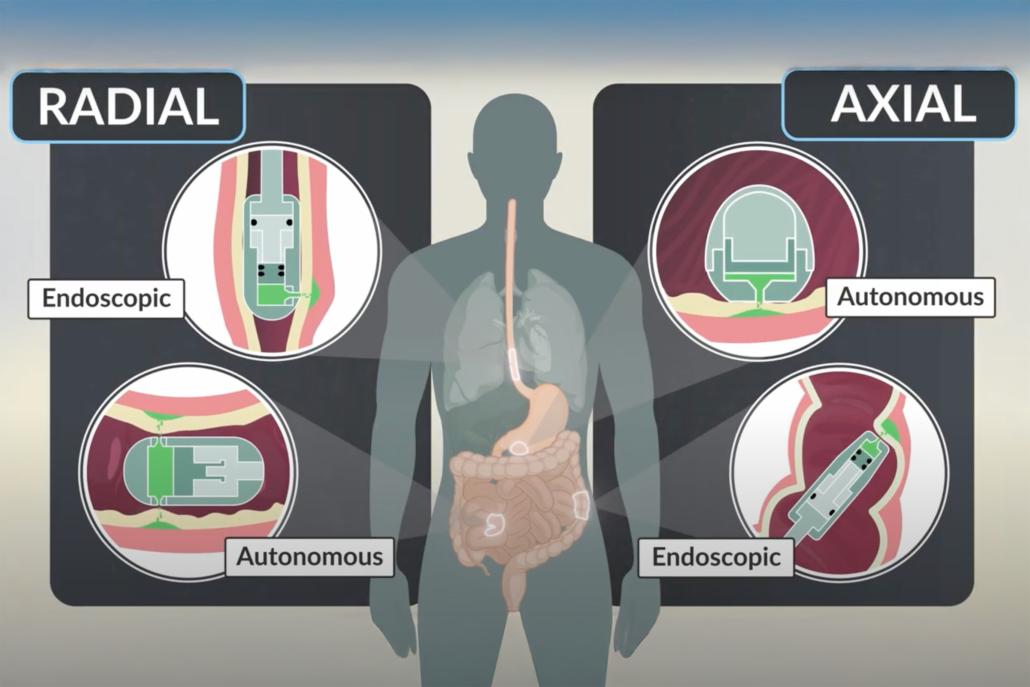Novel squid-inspired gastrointestinal capsule enables macromolecular drug delivery
MIT and Novo Nordisk researchers have developed an ingestible capsule system that could enable oral delivery of medications typically requiring injection, such as insulin and therapeutic proteins. The needle-free device uses a biomimetic jet propulsion mechanism inspired by cephalopod physiology.

The researchers designed the capsules so that they can target different parts of the digestive tract. A second version has a tube-like shape that allows it to align itself within a long tubular organ. Another version of the device could be attached to an endoscope. © Courtesy of the Researchers
The development stems from observations of how squids and octopuses propel themselves through water and expel ink clouds via their siphon organs. This biological mechanism provided the blueprint for the researchers to design a drug delivery system that can project therapeutic compounds directly into the gastrointestinal tract wall without needles.
The device utilises either compressed carbon dioxide or coiled springs to generate the requisite force for drug propulsion. A carbohydrate-based trigger, responsive to humidity or acidic environments, maintains the propulsion mechanism in a compressed state until reaching the target location. Upon dissolution of the trigger, the stored energy creates a high-velocity jet of medication.
Professor Giovanni Traverso, director of the Laboratory for Translational Engineering at MIT and the study’s senior author, explained: “One of the longstanding challenges that we’ve been exploring is the development of systems that enable the oral delivery of macromolecules that usually require an injection to be administered. This work represents one of the next major advances in that progression.”
Versatile design approach
The researchers developed two distinct configurations of the capsule. The first variant, approximately the size of a blueberry, features a flat base with a domed top and can deliver 80 microliters of medication. This design enables the capsule to maintain a stable orientation on surfaces such as the stomach lining.
The second configuration adopts a tubular shape, allowing it to self-align within elongated organs such as the oesophagus or small intestine. This version can accommodate a larger payload of 200 microliters and releases medication laterally into the surrounding tissue.
Promising preliminary results
Lead author Graham Arrick highlighted a key advantage of the jet-based delivery system: “Aside from the elimination of sharps, another potential advantage of high-velocity columnated jets is their robustness to localization issues. In contrast to a small needle, which needs to have intimate contact with the tissue, our experiments indicated that a jet may be able to deliver most of the dose from a distance or at a slight angle.”
Animal studies demonstrated the capsule’s capability to deliver insulin, GLP-1 receptor agonists, and short interfering RNA (siRNA). The researchers reported achieving blood concentration levels comparable to traditional injection methods, with no observable tissue damage from the drug delivery mechanism.
Clinical potential
The technology could offer particular benefits for patients requiring frequent administration of injectable medications. The capsules, constructed from metal and plastic components, safely transit through the digestive system after drug delivery. The researchers have also developed an endoscope-mounted variant for clinical procedures.
The research team is now focusing on further refinement of the technology with the aim of progressing to human trials. The study, published in Nature on 20 November 2024, was supported by funding from Novo Nordisk, various research councils, and academic institutions including MIT and Brigham and Women’s Hospital.
Reference:
Arrick, G., Sticker, D., Ghazal, A., et al. Cephalopod-inspired jetting devices for gastrointestinal drug delivery. Nature. 20 November 2024. https://doi.org/10.1038/s41586-024-08202-5

